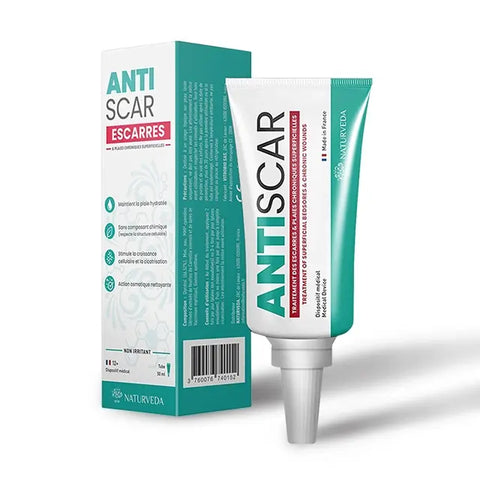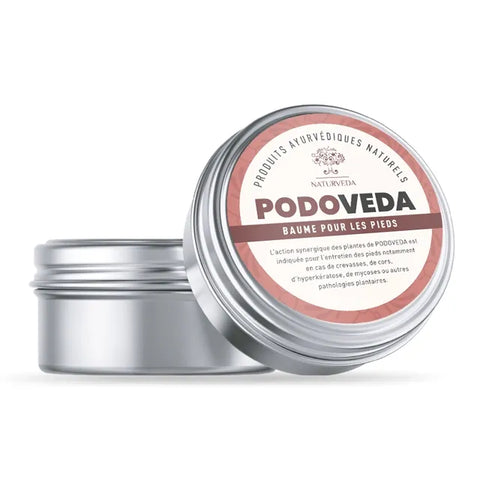2 products
Ulcère Veineux : Comprendre, Prévenir et Traiter cette Affection Cutanée Courante
Vous êtes-vous déjà demandé ce qu'est un ulcère veineux? Ne cherchez plus, car nous avons toutes les réponses à vos questions. Dans cet article, nous allons couvrir tout ce que vous devez savoir sur cet état de santé complexe, y compris comment le prévenir, comment il se manifeste et comment s'en débarrasser.
Un ulcère veineux, également appelé ulcère de jambe, est une plaie qui met généralement longtemps à guérir - souvent plusieurs semaines ou plus. Il est généralement causé par une mauvaise circulation sanguine dans les jambes. C'est une affection chronique qui peut causer des douleurs significatives et affecter considérablement la qualité de vie.
Découvrir que vous avez un ulcère veineux peut être effrayant, mais ne vous inquiétez pas. Il existe plusieurs moyens efficaces pour gérer cette condition et même l'éviter. Alors, asseyez-vous, mettez-vous à l'aise et continuons ensemble cette exploration informative.
Identification des Symptômes de l'Ulcère Veineux
L'ulcère veineux se manifeste souvent par des signes qui peuvent sembler banals au début. Vous pouvez ressentir une sensation de lourdeur ou de fatigue dans vos jambes, surtout lorsque vous restez debout pendant de longues périodes. Vous pouvez également remarquer des douleurs, des démangeaisons ou un gonflement autour de la zone concernée.
Cependant, le symptôme principal de l'ulcère veineux est l'apparition d'une plaie ouverte sur la peau. Cette plaie peut prendre du temps à guérir, souvent plusieurs semaines ou même plusieurs mois, et elle peut suinter un liquide jaunâtre. Il est important de consulter un médecin dès que vous observez de tels signes. Ne tardez pas, car l'ulcère veineux peut entraîner des complications sérieuses si non traité.
Souvenez-vous : l'ulcère veineux n'est pas une maladie à prendre à la légère. C'est une pathologie qui nécessite une prise en charge médicale appropriée. Écoutez votre corps, respectez vos symptômes et n'hésitez pas à demander de l'aide à votre médecin.
Facteurs de Risque et Prédispositions à l'Ulcère Veineux
Un ulcère veineux est une plaie chronique qui se développe généralement sur la partie inférieure de la jambe. Cette affection est causée par une mauvaise circulation sanguine. Pour comprendre ses manifestions, imaginons d'abord que vos veines sont comme des autoroutes pour le sang. Quand tout va bien, elles permettent un flux régulier, assurant une bonne oxygénation de vos tissus. Cependant, si ces "routes sanguines" sont endommagées, l'oxygénation est compromise, ce qui peut à la longue conduire à la formation d’ulcères veineux.
Il est possible de prévenir l'apparition d'un ulcère veineux en surveillant et en gérant les facteurs de risque. Ceux-ci comprennent l'âge, l'obésité, l'immobilité et un historique familial d'ulcères veineux. Une alimentation saine, l'exercice régulier, la gestion du poids et la limitation du temps passé en position assise ou debout sont des mesures de prévention efficaces.
Les ulcères veineux se manifestent généralement par des douleurs, une enflure, une peau qui change de couleur ou devient plus épaisse et, dans certains cas, par la formation d'une plaie qui ne guérit pas. Si ces signes et symptômes apparaissent, il est important de consulter un professionnel de la santé sans tarder.
Heureusement, l'ulcère veineux est une condition que l'on peut traiter. Les méthodes de traitement varient en fonction de la gravité de l'ulcère, mais peuvent impliquer l'utilisation de compresses médicales, la prise de médicaments pour améliorer la circulation sanguine, une intervention chirurgicale et parfois même une combinaison de ces méthodes. Une fois l'ulcère guéri, il est crucial de continuer à surveiller régulièrement la zone pour s'assurer qu'il ne revienne pas.
Stratégies Préventives Contre l'Ulcère Veineux
Pour éviter l'apparition des ulcères veineux, il existe des habitudes de vie que vous pouvez adopter au quotidien. Une bonne hygiène de vie est toujours la meilleure des préventions. Maintenez une bonne activité physique : Favorisez la marche et l'exercice régulier pour stimuler la circulation du sang dans les jambes. Evitez les longues périodes d'immobilité ou de position assise, qui peuvent freiner la circulation sanguine. Évitez de croiser les jambes : Cette position peut également entraver la circulation du sang. Si vous devez rester assis pendant de longues périodes, pensez à faire des mouvements réguliers avec vos jambes et à vous lever pour marcher un peu. Adoptez une alimentation équilibrée : Une alimentation pauvre en sel et riche en fruits, légumes, et en protéines peut aider à prévenir l'ulcère veineux. Surveillez votre poids : Un surpoids important peut provoquer une pression supplémentaire sur vos veines, favorisant ainsi l'apparition de l'ulcère veineux. Arrêtez de fumer : Le tabac a un effet néfaste sur la circulation sanguine.
Importance d'une Bonne Hygiène de Vie pour Prévenir l'Ulcère Veineux
Entretenir une hygiène de vie saine est primordiale pour prévenir non seulement l'ulcère veineux, mais aussi plusieurs autres maladies. Par ‘hygiène de vie’, il est question de vos habitudes quotidiennes qui influencent votre santé.
La première chose que vous pouvez faire est de faire attention à votre alimentation. Une alimentation équilibrée est richesse en fruits, légumes et fibres, tout en limitant le sel, le sucre et les graisses saturées. Cela aide à maintenir un poids santé, ce qui réduit la pression sur vos jambes.
L’activité physique joue aussi un rôle majeur. Elle favorise la circulation sanguine, réduit l'inflammation et améliore l'état général de vos veines. Même une marche quotidienne de trente minutes peut faire une différence significative. Il est également recommandé de lever les jambes quand vous êtes assis ou couché pour améliorer la circulation.
D'un autre côté, arrêter de fumer peut améliorer grandement votre circulation sanguine, alors que l’abus d’alcool a l’effet inverse. Il est également recommandé de porter des vêtements non serrés, car ils empêchent la circulation correcte du sang.
Enfin, le repos est tout aussi important. Assurez-vous de dormir suffisamment chaque nuit, car le manque de sommeil peut entraîner des problèmes circulatoires qui augmentent le risque d'ulcère veineux.
En résumé, maintenir une bonne hygiène de vie est une étape essentielle dans la prévention de l'ulcère veineux. Rappelez-vous, la prévention est toujours mieux que la guérison.
Traitements Disponibles pour l'Ulcère Veineux
D'abord, il est essentiel de comprendre ce qu'est exactement un ulcère veineux. En fait, c'est une plaie ouverte qui se forme lorsque le sang ne peut pas retourner correctement du bas de la jambe vers le cœur. Cela crée une pression excessive dans les veines des jambes, ce qui peut éventuellement provoquer un ulcère.
Combattre un ulcère veineux peut sembler être une tâche insurmontable, mais ne vous inquiétez pas, nous sommes là pour vous aider à prendre des décisions éclairées sur votre santé. Il y a certaines choses que vous pouvez faire vous-même pour accélérer le processus de guérison et pour éviter l'apparition de nouveaux ulcères.
Maintenir une bonne circulation
Pousser régulièrement vos jambes à bouger peut aider à maintenir une bonne circulation. Marcher est un moyen efficace d'y parvenir. Même si vos jambes vous font mal, il est important de continuer à bouger autant que possible. N'hésitez pas à discuter avec votre médecin de la meilleure façon de gérer votre douleur tout en restant actif.
Un plan de soins adapté à votre cas
Un plan de soins personnalisé est une autre façon efficace de traiter les ulcères veineux. Votre médecin peut élaborer un plan qui comprend le maintien de votre poids optimal, le choix des bonnes chaussures, le suivi des signes d'infection et, si nécessaire, l'utilisation de compressions pour aider à améliorer la circulation.
Les médicaments et les traitements chirurgicaux
Des médicaments peuvent être prescrits pour aider à gérer la douleur et à prévenir les infections. Dans certains cas, un traitement chirurgical peut être nécessaire. Le type de procédure dépendra de l'état précis de votre ulcère veineux. Toute décision concernant la chirurgie doit être prise après de sérieuses discussions avec votre équipe médicale.
En résumé, il est important de savoir que bien que la perspective de gérer un ulcère veineux puisse sembler intimidante, il y a de nombreuses ressources disponibles pour vous aider à traverser cette période difficile.
Méthodes Alternatives pour Soulager l'Ulcère Veineux
Jetons maintenant un coup d'oeil sur quelques alternatives efficaces pour apporter du soulagement en cas d'ulcère veineux. De nombreuses études ont montré que l'application de certaines méthodes dites complémentaires peut aider à gérer symptomatiquement la douleur et à stimuler le processus de guérison.
Une telle approche est l'utilisation des huiles essentielles. Utilisées avec précaution, elles pourraient aider à réduire l'inflammation et cicatriser plus vite. Il ne faut pas oublier que toute utilisation d'huiles essentielles doit être faite sous la direction d'un professionnel de santé pour éviter tout risque éventuel d'irritation cutanée ou d'une réaction allergique.
En plus des huiles essentielles, il existe aussi des solutions naturelles pour soulager les ulcères veineux, comme les crèmes du laboratoire Naturveda. L'un de leurs produits innovants est Antiscar, un traitement spécialement conçu pour les plaies chroniques, les ulcères et les escarres diabétiques.
Ce produit se présente sous la forme d'un pansement liquide novateur qui possède une technologie avancée et une formule unique. Ces caractéristiques font d'Antiscar un remède efficace et rapide pour traiter non seulement les ulcères veineux, mais aussi les plaies chroniques et les escarres. Sa formule exclusive permet non seulement d'accélérer le processus de guérison, mais aussi de minimiser les complications couramment associées à ce type de lésions cutanées.
Aussi, il est important de rappeler que le traitement doit toujours être suivi par un professionnel de la santé, afin de s'assurer qu'il est bien adapté à vos besoins et de prévenir toute réaction indésirable.
Le yoga et la méditation peuvent également apporter un réconfort notable. Bien que ce ne soient pas des remèdes directs à l'ulcère veineux, ces pratiques peuvent aider à gérer le stress, que l'on sait être un facteur exacerbant des douleurs chroniques. De plus, certaines postures de yoga peuvent favoriser une meilleure circulation, contribuant ainsi à prévenir l'apparition de nouveaux ulcères.
Enfin, ne sous-estimez pas l'importance d'une alimentation équilibrée en complément à un régime de soins de santé traditionnel. Une nutrition correcte peut soutenir le processus de guérison en fournissant au corps les nutriments nécessaires à la réparation des tissus endommagés.
Tous ces moyens aident à compléter la médication et les thérapies traditionnelles, favorisant une approche holistique pour une gestion plus efficace de l'ulcère veineux. Comme toujours, toutes ces approches doivent être consultées avec votre médecin pour assure une utilisation sûre et efficace.
Il est important de rappeler l'importance de l'hydratation dans la gestion d’un ulcère veineux. Bien s'hydrater est essentiel pour maintenir une bonne circulation sanguine, ce qui aide à prévenir l'accumulation de fluides dans les membres inférieurs, les varices et l'ulcère veineux. Cela peut être d'autant plus crucial si vous souffrez déjà d'une insuffisance veineuse.
L'eau a un effet bénéfique incontestable sur les veines. En effet, elle contribue à diluer le sang, le rendant moins épais et facilitant sa circulation à travers vos veines. De plus, boire suffisamment d'eau peut également aider à prévenir la constipation, qui peut exercer une pression supplémentaire sur les veines du rectum et aggraver l'insuffisance veineuse.
Il est recommandé de boire au moins 1,5 à 2 litres d'eau par jour, mais cette quantité peut varier en fonction de votre taille, de votre poids et de votre niveau d'activité physique. Il est important de noter que l'hydratation ne se limite pas à l'eau ; vous pouvez également consommer d'autres liquides non sucrés et manger des fruits et légumes riches en eau.
En ce qui concerne l'hydratation de la plaie de l'ulcère veineux, cela revêt une importance particulière. Une bonne hydratation contribue à la cicatrisation des plaies et aide à prévenir les infections. Les plaies, qu'il s'agisse d'un ulcere, d'un tatouage ou d'une cicatrisation post chirurgicale, doivent rester propres et humides pour favoriser leur guérison. C'est ainsi que vous pouvez utiliser des pansements hydrocolloïdes ou à base de gel pour maintenir l'hydratation. Il faut prendre soin d'éviter les pansements qui pourraient assécher la plaie.




